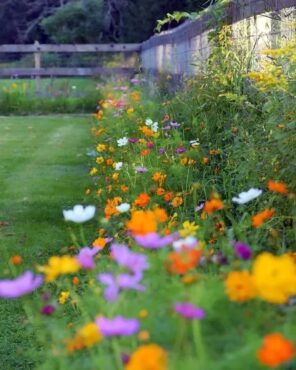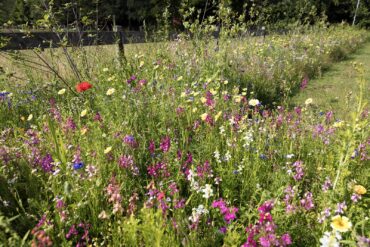
Are you tired of spending every Saturday mowing your lawn instead of relaxing in the garden? Was your last water bill higher than your car payment? Would you rather spend money on pretty plants for the garden — instead of fertilizer for the lawn? And — do you worry about the environmental impact when lawns require so much water, mowing and chemicals?
If your lawn gives you more headaches than happiness, it’s time to embrace meadowscaping.
What Is Meadowscaping?
Meadowscaping replaces traditional lawns with wildflowers and grasses to create a wonderfully wildlife-friendly, vibrant meadow-like aesthetic with enormous ecological benefits.
Meadowscaping can involve:
- Replacing an entire front lawn with beneficial plants.
- Creating a beautiful border of wildflowers and grasses along your property line.
- Purposefully planting a portion of your yard with environmentally beneficial native plants.
Why Choose Meadowscaping?
Whether you want to reduce your carbon footprint, attract more birds, bees and butterflies to your yard, or simply prefer relaxing surrounded by pretty plants instead of hauling out the lawnmower every weekend, meadowscaping makes an excellent alternative to turf lawns.
Once established, low-maintenance meadowscapes require less labor and expense than traditional lawns.
Tip: Before you begin ripping up your front lawn to transition it to meadowscaping, make sure to check your Homeowners’ Association rules, as well as any local ordinances that prohibit a front yard planted entirely in wildflowers and ornamental grasses.
While many communities embrace the meadowscaping movement — with some municipalities even paying residents as an incentive to remove turfgrass in favor of more sustainable plantings — not everyone is enamored with less lawns.
 How to Start Meadowscaping
How to Start Meadowscaping
If you’re a little nervous about digging up your entire lawn, take some time to decide how much meadowscaping you want to include in your landscape. Whether you intend to plant your entire front landscape with wildflowers or prefer to leave a patch of lawn for the kids’ soccer practice, any transition you make to less lawn helps the environment.
While you might not be ready to rid your entire property of turf grass, you can still incorporate meadowscaping into borders, backyard seating areas or in “hell-strips” — that challenging area between the sidewalk and street. Starting with a small meadowscape makes sense: You can determine what flowers and grasses work well in your sites before undergoing an entire lawn excavation and renovation.
Tip: Use a sign to help quell the worries of neighbors as you install a front-yard meadowscape.
It takes time for a meadowscape to establish into a beautiful, blooming ecosystem — and it can look a little barren until flowers fill in. By placing a temporary sign in your yard that states “Meadow in Progress” or “Future Wildlife Habitat,” you’ll help answer neighbors’ questions before they can even ask them!
Once the meadow becomes a beautiful, thriving wildlife habitat, consider adding a pretty, permanent sign to help educate your community about the benefits of meadowscaping.
Plan and Prep Your Space
Before you order your first seeds or pick out native plants, spend some time evaluating the space for your future meadow. Check the amount of sunlight it receives throughout the day, as well as throughout the seasons. Sunlight may be more prevalent in early spring than later in summer when deciduous trees leaf out and provide shade.
Also, check if any outbuildings or fences shade the meadow space throughout the day. While many wildflower mixes and plants prefer full sun, you’ll also find excellent options for shady spaces — you just need to know how much sun your future meadow space receives to plan accordingly.
Along with light, check your soil. Consider taking a soil sample of the future meadow space to your local university extension agent. By analyzing the soil early in the process, you’ll learn its pH, composition and any micronutrients missing in the soil.
Most soil test reports tell you how to amend your soil, if necessary, based on what you plan to grow. By understanding your soil, you can make any necessary amendments before you start planting to help ensure the health of your new meadow.
Prep Your Site
Whether this involves removing turf grass, smothering weeds or tilling soil, ensure that your future meadow’s area is free from weeds, roots, rocks, sticks and other debris before you begin planting.
Removing grass and weeds reduces competition for light, nutrients and water, making space for new plants to thrive. Creating a space with good, debris-free soil allows seeds contact with soil, helping them to germinate well, and encourages healthy root development for your plants.
If you’re removing turf grass, you have several options:
- Rototilling
- Sod cutters
- Hand tools,
- No-till solarization and smothering
- No-till sheet mulching
You might find information that recommends using herbicides, but that’s counterproductive to the goal of using less chemicals in your garden. Plus, using herbicides means that you’ll need to wait a while to plant your meadow, as the chemicals that remain in the soil can kill your new seedlings and plants.
For excellent information on how to remove your lawn, check out the tips from National Garden Bureau member American Meadows.
Factors to Consider
Whether you choose wildflower seeds or established perennial plants for your meadowscaping project depends on several factors. While we’d all love to plant a meadow full of beautiful, mature plants that instantly create a gorgeous garden space, fully grown plants are more expensive but create instant color.
To create a pretty meadow cost-effectively, consider a combination of sowing seeds and planting established perennials. Because it may take perennials grown from seed up to three years before blooming, it makes sense to allocate a portion of your budget to purchasing established perennials to give the meadow a head start.
Annual seeds, like wild cosmos and blanket flower, provide almost instant gratification. Within a short period of time, you’ll enjoy pretty blooms of annuals. Annual wildflower seeds last one season — but many also self-seed, providing blooms for the following year.
Annual flowers provide a lush look in the first year, while most perennial seeds take time to establish in the garden. Spending part of your budget on some of your favorite perennial plants allows you to enjoy your favorite flowers, while you patiently wait for perennial seeds to germinate, grow, and thrive.
Consider adding high-value, showy perennial plants that attract many pollinators, like coneflowers, black-eyed Susan, milkweed and salvia.
Select Your Seeds and Plants
When choosing seeds and plants for your meadowscape, consider species that match your goals. If you’re looking to attract pollinators, choose flowers beloved by bees and butterflies. Want to attract hummingbirds? Add tubular flowers with high nectar content. If bird watching is your favorite pastime, plant grasses that birds adore and leave the seedheads on flowers to feed the birds.
You’ll find a great assortment of seed mixes for your meadow, with many of them labeled with their benefits, as well as growing region. Whether you’re looking for wildflower mixes that Save the Bees Mix, Monarch Butterfly Mix, Bird Lovers Mix, Deer-resistant Wildflowers, or a Mix Ideal for Shade, you’ll find the perfect meadow mix from National Garden Bureau members.
Maintaining Your Meadowscape
Unlike high-maintenance lawns, meadowscapes remain fairly maintenance-free during the growing season. As the seeds germinate and young plants grow, you may need to water a bit, particularly during droughts. Make sure seedlings don’t dry out. But once established, the meadow should thrive on rainwater alone.
However, meadows do require some maintenance to look their best, especially during the first few years. Until the meadow is well-established, it’s important to manage weeds. Weeds can outcompete seedlings for water, nutrients and light, making weed control an important part of your maintenance plan.
For seeded meadows, manage weeds by mowing during the first few years. For planted meadows, hand-weed around the plants and mulch the area to discourage weed germination until the plants fill in.
Once established, meadows are virtually maintenance-free. Just cut the meadow in early spring, raking away dead vegetation to allow seeds and plants to flourish.
A low-maintenance, environmentally friendly, beautifully-blooming meadowscape: Doesn’t that sound like a delight?
Instead of lugging out the lawn mower every weekend, relax on your porch with an icy glass of your favorite beverage and watch the bees, butterflies and birds enjoy your magnificent meadowscape!





























